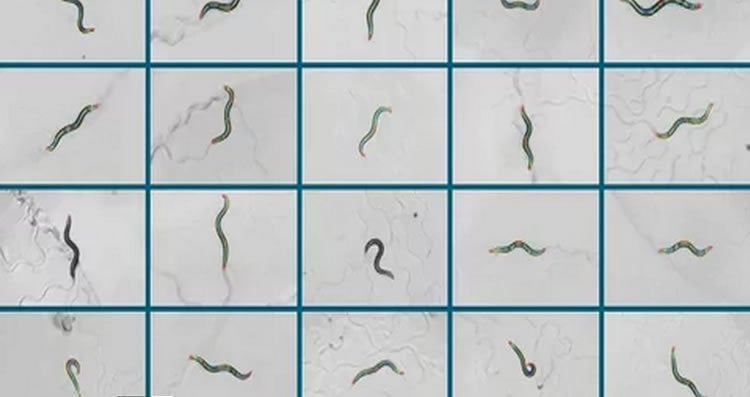The wriggling and writhing of worms may hold clues to the inner workings of our brains, according to scientists at the MRC’s Clinical Sciences Centre at Imperial College London. The researchers have developed a pioneering tool to analyse a worm’s posture as it wriggles, and will use the tool to investigate how exactly the worm’s brain controls its movements.
Recent advances in technology mean that scientists are now able to gather huge amounts of data about the genes associated with movement and about the activity of nerve cells, or neurons, which drive that activity – whether in worms or in people.
What scientists don’t yet have are the tools to investigate how the whole system comes together, that is how differences in genes change neuronal activity in the brain which ultimately affects physical movement, as muscles contract and relax.
This is where the worms come in. If scientists can develop techniques to study the entire process in worms, they may one day be able to extend them to human movement. By understanding more about how this works in a healthy person, the hope is to find clues to what goes wrong in conditions such as depression, anxiety and schizophrenia – though that’s a long way off.
In this latest work, the researchers created a library of shapes such that each depicts a key posture adopted by a small worm. This nematode worm, Caenorhabditis elegans, is a mainstay of scientific research. It’s the only animal for which scientists have established how all of its neurons are connected. It is also a good model for the human brain because some of the genes that encode its neurons can be found in people, and many of the molecules that its neurons use to communicate with each other, such as dopamine and serotonin, are thought to play similar roles in the human brain.

Nematode worms move by bending sections of their body in turn, to create a wave of movement. Andre Brown, who is head of the Behavioural Genomics group at the CSC and who led the research, has developed an automated camera to track a worm’s movement. It takes 30 static images of the worm’s shape, or posture, every second to make sure that it captures even subtle changes.
A computer then assigns the posture a numerical value between 1 and 90, each of which denotes a benchmark posture. The sequence of postures that a worm adopts over time is then represented by a string of numbers.
This numerical data can then be linked to information from separate studies on the worms’ genes and neuronal activity, to try to spot any associations between posture, neuronal activity and genes – that elusive bigger picture.
The scientists say that their inspiration for studying the building blocks of behaviour came from patterns in language, where words are repeated in different sequences to create sentences. Behaviours, they suggest, are made up of a similar sequence of repeated movements.
Researchers at the MRC’s Laboratory of Molecular Biology in Cambridge, and the European Bioinformatics Institute in Hixton, worked with Brown on the study published today in PLOS Biology. Together they monitored the movement of 18 strains of worms from across the world, each with slightly different genes. They found that the worms’ postures varied between strains, much as people’s accents can vary between regions.
Linking each worm’s ‘accent’ to the genes of that strain could also hold clues to a better understanding of the genes and neurons behind behaviours. One day, scientists may be able to make similar links in humans.
“Worms are a testing ground,” says Brown. “We still don’t know the best ways to measure behaviour. We think that what we learn from studying worms will also help with more complex organisms, and ultimately influence how we measure human behaviours.”
Source: Susan Watts – Imperial College London
Image Credit: The image is credited to Andre Brown
Video Source: The video is available via the cscweb Vimep page
Original Research: The full open access research paper “Changes in postural syntax characterize sensory modulation and natural variation of C. elegans locomotion” by Roland F. Schwarz, Robyn Branicky, Laura J. Grundy, William R. Schafer, and André E.X. Brown will be published in PLOS Biology. Advanced access of the abstract is available via bioRxiv doi:10.1101/017707
Abstract
Changes in postural syntax characterize sensory modulation and natural variation of C. elegans locomotion
Locomotion is driven by shape changes coordinated by the nervous system through time; thus, enumerating an animal’s complete repertoire of shape transitions would provide a basis for a comprehensive understanding of locomotor behaviour. Here we introduce a discrete representation of behaviour in the nematode C. elegans. At each point in time, the worm’s posture is approximated by its closest matching template from a set of 90 postures and locomotion is represented as sequences of postures. The frequency distribution of postural sequences is heavy-tailed with a core of frequent behaviours and a much larger set of rarely used behaviours. Responses to optogenetic and environmental stimuli can be quantified as changes in postural syntax: worms show different preferences for different sequences of postures drawn from the same set of templates. A discrete representation of behaviour will enable the use of methods developed for other kinds of discrete data in bioinformatics and language processing to be harnessed for the study of behaviour.






